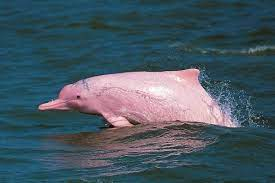Pink dolphins, also known as Amazon river dolphins or boto dolphins, are some of the most enchanting and unique creatures found in the world's rivers and estuaries. These dolphins, scientifically known as Inia geoffrensis, are celebrated for their striking pink coloration, intelligence, and distinct behavior.
The Pink Hue: A Unique Trait
One of the most remarkable features of pink dolphins is, of course, their pinkish coloration. While they are born gray, as they age, their skin gradually turns pink. The intensity of their pink hue can vary from light to a vibrant, almost bubblegum pink. This distinctive coloration has earned them the nickname "pink dolphins" and sets them apart from other dolphin species.
Adaptation to Freshwater Ecosystems
Pink dolphins primarily inhabit freshwater environments, particularly in the Amazon and Orinoco river basins in South America. Unlike their marine cousins, these dolphins have adapted to thrive in freshwater habitats, which present a unique set of challenges. Their physical characteristics, such as a flexible neck and longer snout, help them navigate through the dense vegetation and murky waters of these rivers. These adaptations make them highly specialized for life in freshwater ecosystems.
Social and Intelligent Beings
Pink dolphins are known for their social nature. They often travel in small groups or pods, typically composed of family members. These intelligent creatures are known to display playful and curious behavior, frequently leaping out of the water and interacting with each other. Their communicative abilities include a wide range of clicks, whistles, and body language, facilitating group coordination and hunting strategies.
Unique Hunting Techniques
Unlike their marine counterparts, pink dolphins primarily feed on fish found in their freshwater habitats. They employ unique hunting techniques, such as corralling and herding fish into small groups before making a coordinated attack. This collaborative hunting style showcases their intelligence and adaptability to their environment.
Challenges of Pink Dolphin Conservation
Despite their fascinating qualities, pink dolphins face numerous challenges that threaten their populations. The primary threats to these unique creatures include habitat loss, water pollution, and accidental entanglement in fishing nets. As human activities like logging, agriculture, and urban development encroach on their habitats, pink dolphins find themselves with diminishing living spaces. Additionally, pollution from agricultural runoff and mining operations has led to water contamination, impacting their health and the availability of prey.
Conservation Efforts
Thankfully, several conservation organizations and local communities are working tirelessly to protect pink dolphins. Conservation initiatives focus on habitat restoration, reducing water pollution, and creating protected areas for these dolphins. Education and awareness programs are crucial in promoting the significance of pink dolphins in maintaining the health of freshwater ecosystems.
The Role of Eco-Tourism
Eco-tourism plays a vital role in raising awareness and funding for pink dolphin conservation. Tourists are drawn to regions where they can catch a glimpse of these enchanting creatures in their natural habitat. Responsible eco-tourism practices ensure that interactions with pink dolphins are non-intrusive and do not harm these gentle beings or their environment.
The Cultural Significance
In regions where pink dolphins reside, they often hold cultural and spiritual significance. Many indigenous communities believe that these dolphins possess supernatural powers and are protectors of the river. This cultural reverence can provide an added layer of protection to pink dolphins, as local communities become advocates for their conservation.
Pink dolphins are not only captivating creatures due to their distinctive appearance but also integral components of the ecosystems they inhabit. Their remarkable adaptability to freshwater environments and social behavior offer valuable insights into the interconnectedness of all life on Earth.
